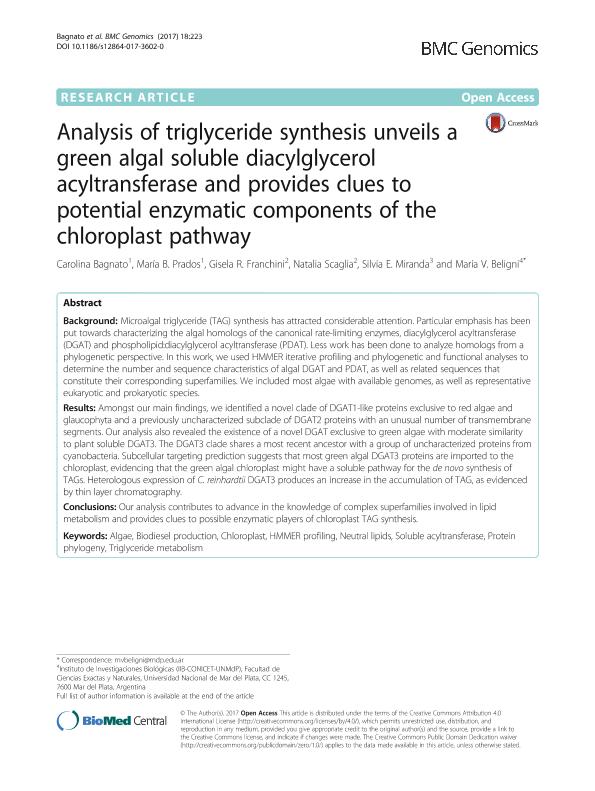Mostrar el registro sencillo del ítem
dc.contributor.author
Bagnato, Carolina

dc.contributor.author
Prados, Maria Belen

dc.contributor.author
Franchini, Gisela Raquel

dc.contributor.author
Scaglia, Natalia

dc.contributor.author
Miranda, Silvia Esther

dc.contributor.author
Beligni, María Verónica

dc.date.available
2018-12-17T19:32:38Z
dc.date.issued
2017-03
dc.identifier.citation
Bagnato, Carolina; Prados, Maria Belen; Franchini, Gisela Raquel; Scaglia, Natalia; Miranda, Silvia Esther; et al.; Analysis of triglyceride synthesis unveils a green algal soluble diacylglycerol acyltransferase and provides clues to potential enzymatic components of the chloroplast pathway; BioMed Central; BMC Genomics; 18; 1; 3-2017
dc.identifier.issn
1471-2164
dc.identifier.uri
http://hdl.handle.net/11336/66600
dc.description.abstract
Background: Microalgal triglyceride (TAG) synthesis has attracted considerable attention. Particular emphasis has been put towards characterizing the algal homologs of the canonical rate-limiting enzymes, diacylglycerol acyltransferase (DGAT) and phospholipid:diacylglycerol acyltransferase (PDAT). Less work has been done to analyze homologs from a phylogenetic perspective. In this work, we used HMMER iterative profiling and phylogenetic and functional analyses to determine the number and sequence characteristics of algal DGAT and PDAT, as well as related sequences that constitute their corresponding superfamilies. We included most algae with available genomes, as well as representative eukaryotic and prokaryotic species. Results: Amongst our main findings, we identified a novel clade of DGAT1-like proteins exclusive to red algae and glaucophyta and a previously uncharacterized subclade of DGAT2 proteins with an unusual number of transmembrane segments. Our analysis also revealed the existence of a novel DGAT exclusive to green algae with moderate similarity to plant soluble DGAT3. The DGAT3 clade shares a most recent ancestor with a group of uncharacterized proteins from cyanobacteria. Subcellular targeting prediction suggests that most green algal DGAT3 proteins are imported to the chloroplast, evidencing that the green algal chloroplast might have a soluble pathway for the de novo synthesis of TAGs. Heterologous expression of C. reinhardtii DGAT3 produces an increase in the accumulation of TAG, as evidenced by thin layer chromatography. Conclusions: Our analysis contributes to advance in the knowledge of complex superfamilies involved in lipid metabolism and provides clues to possible enzymatic players of chloroplast TAG synthesis.
dc.format
application/pdf
dc.language.iso
eng
dc.publisher
BioMed Central

dc.rights
info:eu-repo/semantics/openAccess
dc.rights.uri
https://creativecommons.org/licenses/by-nc-sa/2.5/ar/
dc.subject
Algae
dc.subject
Biodiesel Production
dc.subject
Chloroplast
dc.subject
Hmmer Profiling
dc.subject
Neutral Lipids
dc.subject
Protein Phylogeny
dc.subject
Soluble Acyltransferase
dc.subject
Triglyceride Metabolism
dc.subject.classification
Otras Ciencias Biológicas

dc.subject.classification
Ciencias Biológicas

dc.subject.classification
CIENCIAS NATURALES Y EXACTAS

dc.title
Analysis of triglyceride synthesis unveils a green algal soluble diacylglycerol acyltransferase and provides clues to potential enzymatic components of the chloroplast pathway
dc.type
info:eu-repo/semantics/article
dc.type
info:ar-repo/semantics/artículo
dc.type
info:eu-repo/semantics/publishedVersion
dc.date.updated
2018-10-22T22:37:59Z
dc.journal.volume
18
dc.journal.number
1
dc.journal.pais
Reino Unido

dc.journal.ciudad
Londres
dc.description.fil
Fil: Bagnato, Carolina. Consejo Nacional de Investigaciones Científicas y Técnicas; Argentina. Comisión Nacional de Energía Atómica. Centro Atómico Bariloche; Argentina
dc.description.fil
Fil: Prados, Maria Belen. Consejo Nacional de Investigaciones Científicas y Técnicas; Argentina. Comisión Nacional de Energía Atómica. Centro Atómico Bariloche; Argentina
dc.description.fil
Fil: Franchini, Gisela Raquel. Consejo Nacional de Investigaciones Científicas y Técnicas. Centro Científico Tecnológico Conicet - La Plata. Instituto de Investigaciones Bioquímicas de La Plata "Prof. Dr. Rodolfo R. Brenner". Universidad Nacional de la Plata. Facultad de Ciencias Médicas. Instituto de Investigaciones Bioquímicas de La Plata "Prof. Dr. Rodolfo R. Brenner"; Argentina
dc.description.fil
Fil: Scaglia, Natalia. Consejo Nacional de Investigaciones Científicas y Técnicas. Centro Científico Tecnológico Conicet - La Plata. Instituto de Investigaciones Bioquímicas de La Plata "Prof. Dr. Rodolfo R. Brenner". Universidad Nacional de la Plata. Facultad de Ciencias Médicas. Instituto de Investigaciones Bioquímicas de La Plata "Prof. Dr. Rodolfo R. Brenner"; Argentina
dc.description.fil
Fil: Miranda, Silvia Esther. Consejo Nacional de Investigaciones Científicas y Técnicas. Oficina de Coordinación Administrativa Houssay. Instituto de Investigaciones Cardiológicas. Universidad de Buenos Aires. Facultad de Medicina. Instituto de Investigaciones Cardiológicas; Argentina
dc.description.fil
Fil: Beligni, María Verónica. Consejo Nacional de Investigaciones Científicas y Técnicas. Centro Científico Tecnológico Conicet - Mar del Plata. Instituto de Investigaciones Biológicas. Universidad Nacional de Mar del Plata. Facultad de Ciencias Exactas y Naturales. Instituto de Investigaciones Biológicas; Argentina
dc.journal.title
BMC Genomics

dc.relation.alternativeid
info:eu-repo/semantics/altIdentifier/doi/https://dx.doi.org/10.1186/s12864-017-3602-0
dc.relation.alternativeid
info:eu-repo/semantics/altIdentifier/url/https://bmcgenomics.biomedcentral.com/articles/10.1186/s12864-017-3602-0
Archivos asociados
